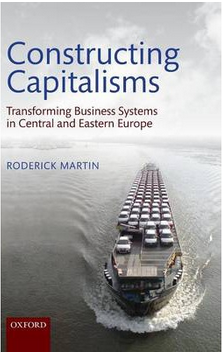
Constructing Capitalisms : Transforming Business Systems in Central and Eastern Europe
[BOOK DESCRIPTION]
This book provides an analysis of the changes in business systems of four Central and Eastern European countries - Poland, Hungary, the Czech Republic, and Romania - since the fall of Communism in 1989.
[TABLE OF CONTENTS]
List of Tables xii
List of Abbreviations xiv
Introduction 1 (7)
1 Roads to capitalism: alternative 8 (30)
approaches to post-socialist capitalisms
1.1 Introduction 8 (1)
1.2 Alternative models of capitalism 9 (10)
1.3 Neo-institutional theory 19 (6)
1.4 Post-socialist capitalisms 25 (7)
1.5 Path dependence 32 (4)
1.6 Conclusion 36 (2)
2 Poland, the Czech Republic, Hungary, and 38 (28)
Romania: political and economic contexts
2.1 Introduction 38 (2)
2.2 Political contexts 40 (12)
2.2.1 Poland 45 (2)
2.2.2 The Czech Republic 47 (1)
2.2.3 Hungary 48 (2)
2.2.4 Romania 50 (2)
2.3 Economic contexts 52 (11)
2.3.1 Economic performance 52 (2)
2.3.2 Economic structure 54 (1)
2.3.3 Employment 55 (1)
2.3.4 Unemployment 56 (2)
2.3.5 Income inequality 58 (1)
2.3.6 Education 59 (1)
2.3.7 Innovation 59 (2)
2.3.8 The financial crisis 2008-11 61 (2)
2.4 Summary and conclusion 63 (3)
3 Ownership transformation 66 (50)
3.1 Introduction 66 (3)
3.2 Changes in property ownership regimes 69 (10)
under socialism
3.2.1 State and collective ownership 70 (5)
3.2.2 Private ownership 75 (4)
3.3 Transforming property ownership 79 (20)
regimes
3.3.1 Setting the agenda 84 (1)
Privatization: assets 85 (1)
Privatization: methods 86 (1)
Privatization: sequencing and timing 86 (2)
Privatization: initiators and 88 (1)
decision-makers
Asset acquisition entitlements 89 (1)
The role of foreign investment 89 (1)
3.3.2 Implementing the agenda 90 (4)
3.3.3 Changes in property ownership 94 (5)
under post-socialism
3.4 Ownership and control 99 (6)
3.4.1 The theory of real owners 99 (4)
3.4.2 Exit and investor engagement as 103(2)
means of controlling managers
3.5 De novo post-socialist enterprises 105(3)
3.6 Summary and conclusion: property 108(8)
ownership and post-socialist
transformation
4 Capital accumulation 116(33)
4.1 Introduction 116(4)
4.2 Banks 120(11)
4.2.1 Gradual institutional change 121(2)
4.2.2 Growth of foreign ownership 123(5)
4.2.3 Bank contribution to business 128(3)
finance
4.3 Capital markets 131(8)
4.4 International capital investment 139(7)
4.4.1 National origin of international 141(1)
investment
4.4.2 FDI destinations 142(2)
4.4.3 Sector distribution 144(1)
4.4.4 Forms of FDI 145(1)
4.5 Summary and conclusion 146(3)
5 Poland, the Czech Republic, Hungary, and 149(49)
Romania in the international economy
5.1 Introduction 149(2)
5.2 International trade 151(10)
5.3 The role of multinationals 161(8)
5.4 Motor vehicles, electronics, 169(21)
clothing, and pharmaceuticals
5.4.1 Motor vehicles 170(5)
5.4.2 Electronics 175(7)
5.4.3 Clothing 182(4)
5.4.4 Pharmaceuticals 186(4)
5.5 Multinationals and domestically owned 190(2)
enterprises
5.6 Summary and conclusion: incorporating 192(6)
CEE into the global economy
6 The role of the state 198(23)
6.1 Introduction 198(4)
6.2 Building the new economy: governments 202(8)
and business systems
6.3 The state and business 210(4)
6.4 The state and labour 214(4)
6.5 Summary and conclusion 218(3)
7 Segmented capitalisms: one business 221(22)
system or several?
7.1 Introduction 221(6)
7.2 Segmented business systems: Hungary 227(10)
7.2.1 State segment 228(2)
7.2.2 Privatized segment 230(1)
7.2.3 De novo segment 231(2)
7.2.4 International segment 233(4)
7.3 Summary and conclusion: the emergence 237(6)
of segmented capitalisms
8 Managing labour 243(28)
8.1 Introduction 243(2)
8.2 Institutional transformation 245(13)
8.2.1 Trade unions 246(5)
8.2.2 Employers' organizations 251(1)
8.2.3 Employment relations systems 252(4)
8.2.4 Work organization 256(2)
8.3 Management-labour relations: labour 258(4)
weakness
8.4 Segmentation and employment relations 262(4)
8.5 Summary and conclusion 266(5)
9 Conclusion: constructing capitalisms 271(29)
9.1 Introduction 271(1)
9.2 Objectives and direction 272(2)
9.3 The inheritance 274(5)
9.4 Regime transformations 279(12)
9.4.1 Business system integration 281(2)
9.4.2 Managerial and finance capitalisms 283(5)
9.4.3 Governments and business systems 288(3)
9.5 International influences 291(5)
9.6 Types of capitalisms: convergence? 296(4)
References 300(33)
Index 333

 新书报道
新书报道